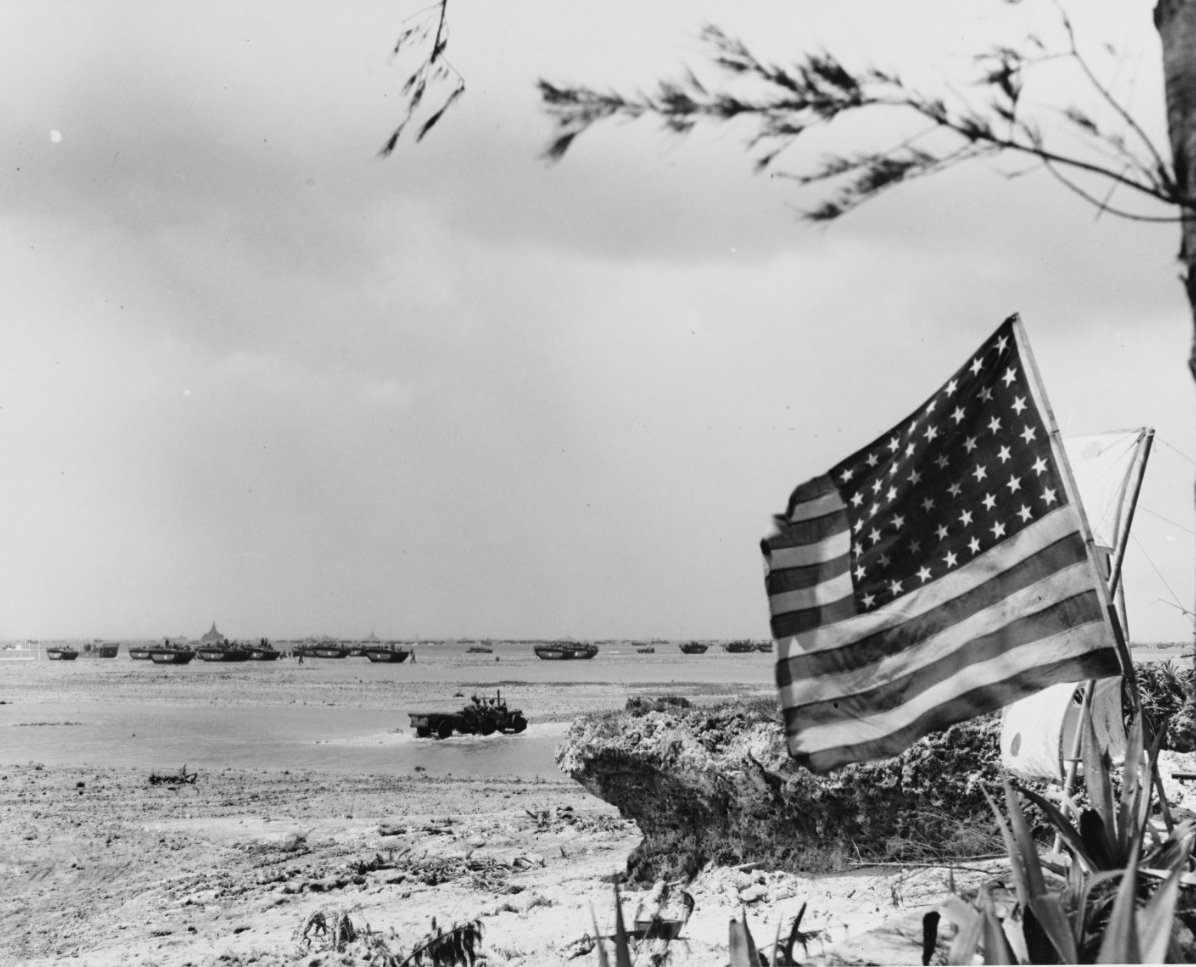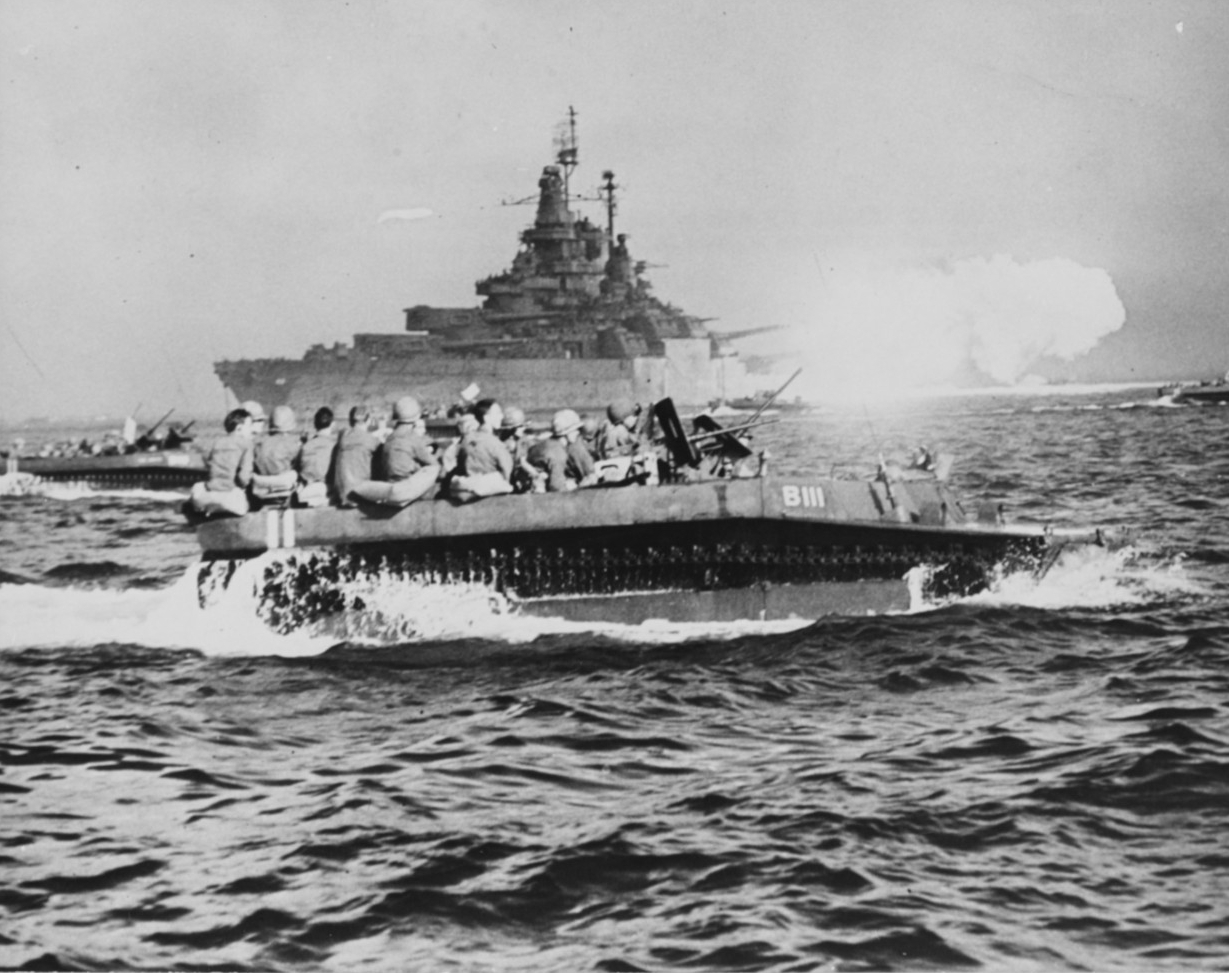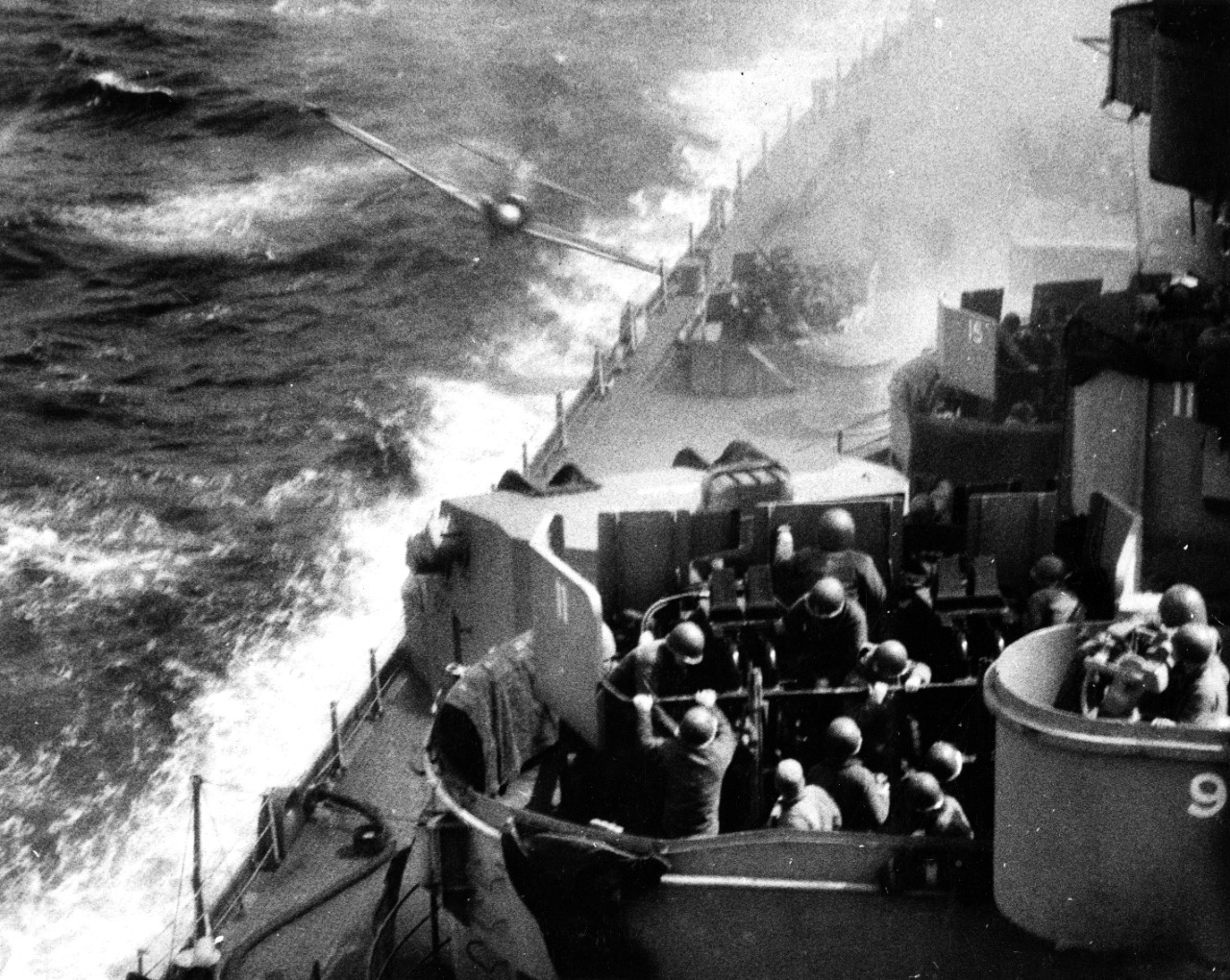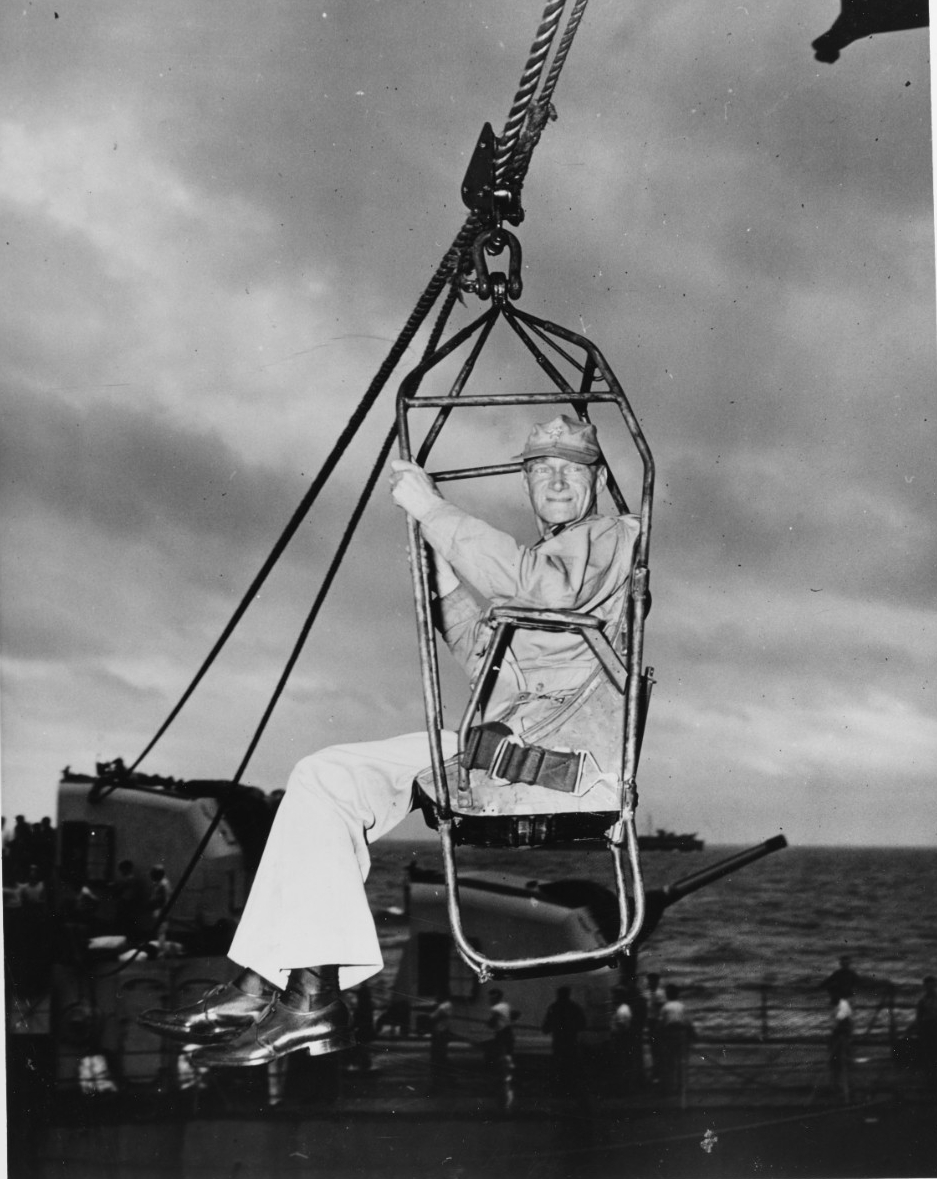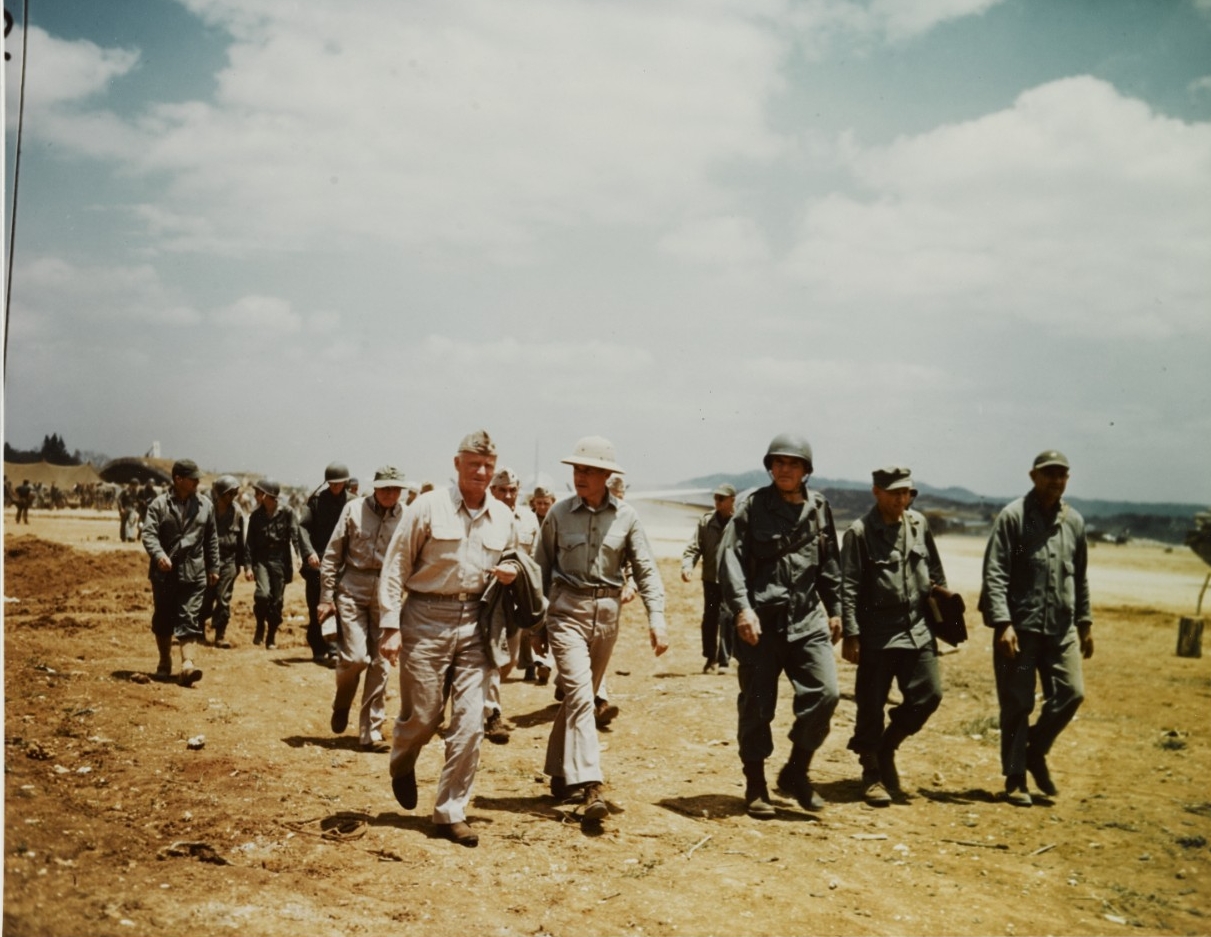Battle of Okinawa: Historic Overview & Importance
For today’s Navy, the Battle of Okinawa is a stark reminder of the importance of integrated American naval power, the necessity of conducting effective joint operations, and the value of being able to learn in real time. Most importantly, it highlights the crucial role that warfighters (both individually and collectively) play in the success of operations, as well as the heavy demands placed on them in a prolonged engagement against an enemy determined to wage a war of attrition at all costs.
Overview
On the very day that the Marines declared organized resistance over on Iwo Jima (16 March 1945), Admiral Raymond Spruance, Fifth Fleet commander, was on board his flagship Indianapolis (CA-35), enroute to the Ryukyus in company with Admiral Marc Mitscher’s Fast Carrier Task Force 58 (TF 58). In the coming weeks, more than 1,600 ships and 350,000 naval personnel from other task forces under Spruance’s overall command would assemble to form the largest amphibious assault force of World War II. Their objective would be to secure the island of Okinawa, thus removing the last barrier standing between the U.S. forces and Imperial Japan. With both this and Iwo Jima firmly in hand, the U.S. military could finally bring its full might to bear upon the Japanese, conducting unchecked strategic air strikes against the Japanese mainland, blockading its logistical lifeline, and establishing forward bases for the final invasion of Japan (Operation Olympic) in the fall of 1945. Before then, however, they would have to endure one of the most brutal battles of the war. A preview of the carnage that awaited came on 19 March while TF 58 conducted strikes against targets on mainland Japan to prepare for the invasion. During the launch of strikes against Honshū and Kobe Harbor, Franklin (CV-13) was hit by two bombs from a Japanese dive bomber. Her crew heroically saved their ship, but more than 800 Sailors died in the attack.
The Japanese military was greatly diminished by this point, but U.S. Navy planners fully anticipated that the ferocity of their resistance would increase the closer they got to the mainland. With the action now mainly concentrated around the Central Philippines and the Ryukus, the Japanese were now close enough to bring their land-based aircraft at Taiwan and Kyushu to bear. They would not, however, be using them to conduct conventional air campaign, but rather, to act as human-guided missiles against U.S. forces. Such tactics had previously been deployed at Leyte Gulf, Luzon and Lingayen, and Iwo Jima, but not on a particularly alarming scale. Now, with Fifth Fleet so close to the Japanese mainland, Navy planners feared that as many as 3,000–4,000 planes could be expected. Regrettably, these estimates proved to be quite on the mark, with the prolonged land battle enabling the Japanese to launch numerous air attacks that proved even more effective than anticipated. Spruance received an early taste of what was to come on 31 March when a diving kamikaze clipped his flagship Indianapolis, severely damaging her with a bomb as it splashed into the sea. This forced Indianapolis to San Francisco for repairs and placed her on a fateful trajectory.
Despite this threat from above, the initial stages of Okinawa proceeded as planned. Minesweeping, pre-invasion bombardments from warships, and tactical strikes from carrier-based aircraft paved the way for an uncontested amphibious landing of Lt. General Simon Bolivar Buckner Jr.’s U.S. Tenth Army (made up of U.S. Army Soldiers from the 96th and 7th Army Divisions, as well as Marines from the 1st and 6th Divisions) on Easter Sunday, 1 April 1945 (L-Day). The force landed on the western side of the island close to the primary objective, two airstrips. Incredibly, these too were taken without contest. Immediately after, the ground force split. Marines moved northeast to secure the northern portion of the island, while the Army moved south towards Shuri. By mid-April, the Marines secured their less defended portion. Army forces, on the other hand, faced more formidable defenses, which led to a slower, more methodical advance. Later joined by the Marines, Army forces slogged it out with the Japanese, suffering high casualties against the well-defended Shuri Line. The fierce nature of the fighting and appalling numbers of casualties taken by U.S. forces continued into June, with the total number of American casualties reaching 49,151, of which 12,520 were killed or missing.
This prolonged land battle had important consequences for the war at sea. With progress occurring much slower than anticipated (particularly on the southern end of the island) and ground forces heavily dependent on Fifth Fleet for fire support and supplies, Spruance’s ships remained on a short leash with no choice but to remain inviting targets for the kamikazes until the island was fully secured. By the time this occurred in June, the protracted naval action had exacted a bloody toll, becoming the costliest naval action of the war (both in terms of men and ships). It is estimated that nearly one out of seven naval deaths in the entire war occurred during these two bloody months off Okinawa.
Possession of Iwo Jima and Okinawa gave the American military considerable latitude as to how it could conduct the war going forward, but the human cost of these ventures raised serious questions among the public and American civil and military leaders as to the practicality of invading the Japanese home islands. With President Franklin Roosevelt dying in the middle of the Okinawa campaign, his successor, Harry Truman, would now have to determine just how much more bloodshed the nation was willing to endure to secure Japan’s unconditional surrender. With the lessons of Okinawa fresh in his mind, he would make the fateful decision to drop two nuclear bombs on Hiroshima and Nagasaki, bringing the war to a close. Thus, the Battle of Okinawa became not only the final major engagement of the war, but a grim testament to what the future might have held for U.S. forces had they continued onwards to the Japanese mainland. This was, however, just one of the important lessons learned during this period.
Preparing the Warfighter
![]() Fifth Fleet engaged in more than two months of sustained combat against a battle-weakened enemy who employed desperate, non-conventional tactics to mitigate U.S. military superiority. Participants from the command level to deck plate were pushed to their very limits, sustaining losses of nearly 5,000 personnel and an equal number of wounded, an almost unprecedented 1:1 killed-to-wounded ratio. Their ships suffered equally, with 36 ships sunk and more than 350 more sustaining varying degrees of damage. Such losses could have been considerably higher were it not for the perseverance and preparation of their crews. Employing the most advanced damage control and firefighting techniques seen in the war thus far, these well-prepared and highly-determined Sailors kept their ships afloat and carried on the fight well past the normal limits of their endurance. Such tenacity would help them to overcome an enemy ready to fight until the bitter end and earned Fifth Fleet the moniker, “The Fleet that Came to Stay.”
Fifth Fleet engaged in more than two months of sustained combat against a battle-weakened enemy who employed desperate, non-conventional tactics to mitigate U.S. military superiority. Participants from the command level to deck plate were pushed to their very limits, sustaining losses of nearly 5,000 personnel and an equal number of wounded, an almost unprecedented 1:1 killed-to-wounded ratio. Their ships suffered equally, with 36 ships sunk and more than 350 more sustaining varying degrees of damage. Such losses could have been considerably higher were it not for the perseverance and preparation of their crews. Employing the most advanced damage control and firefighting techniques seen in the war thus far, these well-prepared and highly-determined Sailors kept their ships afloat and carried on the fight well past the normal limits of their endurance. Such tenacity would help them to overcome an enemy ready to fight until the bitter end and earned Fifth Fleet the moniker, “The Fleet that Came to Stay.”
Missouri (BB-63) about to be hit by a Japanese A6M Zero kamikaze, while operating off Okinawa on 11 April 1945. The plane hit the ship's side below the main deck, causing minor damage and no casualties on board the battleship. A 40mm quad gun mount's crew is in action in the lower foreground. It is believed the photographer was either Seaman Len Schmidt or Harold I. “Buster” Campbell. Collection of Fleet Admiral Chester W. Nimitz. U.S. Naval History and Heritage Command photograph, NH 62696.
The Battle of Okinawa often evokes images of psychologically spent Soldiers and Marines engaged in a grueling land battle. American ships feverishly defending themselves against kamikazes and diving Ohka craft must also have a place in our collective memory, as the number of Sailors killed in the battle actually eclipsed the figures of the other services. For the first time in the Navy’s history, the number of dead exceeded the number of wounded in a campaign.[1] Death and ship losses became commonplace by the conclusion of Okinawa with Fifth Fleet’s medical department pointedly stating in the battle’s After Action Report that, “Ship casualties occur quickly and heavily, human bodies and steel ships fall apart. Wounds are frequently destructive, mutilating, and fearfully mortal."[2] Present for parts of the battle, historian Samuel Eliot Morison actually witnessed kamikaze attacks firsthand. The normally verbose historian confessed, “Words fail him to do justice to the Sailors” on radar pickets who bore the brunt of the kamikaze attacks and had to daily “strike down the flaming terror.”[3] Seeing the aftermath of the attacks remained fresh in his mind years after he wrote the battle’s history. He recalled, “Men wounded in these attacks were for the most part horribly burned. They suffered excruciating agony until given first aid; but if blown overboard, hours might elapse until a pharmacist’s mate could relieve them.”[4]
![]() There were 10 large coordinated kamikaze attacks between early April and mid-June totaling nearly 1,500 planes. On average, 1 out of 6 planes struck an American ship.[5] In addition to the large attacks, smaller attacks harassed U.S. ships on a daily basis, usually at dawn or dusk. As a result, Sailors and ships sustained the longest period of prolonged combat of the war. Okinawa “created a new problem as regards to the morale and well-being of the personnel concerned. It extended over a period of nearly 3 months during which time forces afloat were subjected to almost daily air attacks and night heckling.” Crews responded surprisingly well, though strain and fatigue were visibly evident. Some ships reported a tendency toward carelessness and a disregard of safety precautions which, under normal conditions, would be followed almost automatically.”[6] One form of morale boosting seemed to be allowing repair parties to man the .50 and .30 caliber guns to shoot at planes, even though these weapons were of dubious value in such attacks.[7] The Navy realized after Okinawa that suitable rotations were needed for crews to perform optimally.
There were 10 large coordinated kamikaze attacks between early April and mid-June totaling nearly 1,500 planes. On average, 1 out of 6 planes struck an American ship.[5] In addition to the large attacks, smaller attacks harassed U.S. ships on a daily basis, usually at dawn or dusk. As a result, Sailors and ships sustained the longest period of prolonged combat of the war. Okinawa “created a new problem as regards to the morale and well-being of the personnel concerned. It extended over a period of nearly 3 months during which time forces afloat were subjected to almost daily air attacks and night heckling.” Crews responded surprisingly well, though strain and fatigue were visibly evident. Some ships reported a tendency toward carelessness and a disregard of safety precautions which, under normal conditions, would be followed almost automatically.”[6] One form of morale boosting seemed to be allowing repair parties to man the .50 and .30 caliber guns to shoot at planes, even though these weapons were of dubious value in such attacks.[7] The Navy realized after Okinawa that suitable rotations were needed for crews to perform optimally.
Despite these difficult circumstances, Sailors performed remarkably well and instinctively drew from past experiences and training. Indeed, the losses caused by Japanese air attacks (both conventional and kamikaze) might have been considerably worse were it not for the preparedness and perseverance of U.S. Navy crews who, across the fleet, worked efficiently to extinguish conflagrations before they raged out of control. On board Wasp (CV-18), for example, a five-deck fire caused by a bomb explosion on 19 March was extinguished within 15 minutes, allowing the ship to resume flight operations after it had been hit.[8]
The efforts on board aircraft carrier Franklin that same day were even more heroic. After being hit with two bombs at 0708, her crew worked tirelessly to keep her afloat, even as bombs and ammunition on board exploded all around and smoke threatened to overwhelm them. Chaplain Joseph O’Callahan was among those who participated in these efforts, offering extreme unction to the dying and even manning the fire hoses. Elsewhere, Lt. (j.g.) Donald Gary led a number of his fellow Sailors to safety through smoke-filled corridors and further braved hazardous conditions to raise steam in one of the ship’s firerooms. Nearly five hours of frantic activity later, Franklin’s crew managed to extinguish the last of the fires and stabilized the ship’s list sufficiently to have it taken under tow. Both O’Callahan and Gary would receive the Medal of Honor for their efforts to save the ship, while 19 other individuals would earn the Navy Cross.[9]
Comparatively speaking, Franklin had sustained more damage than carriers Lexington (CV-2) and Yorktown (CV-5), both of which sunk during their respective engagements at Coral Sea (8 May 1942) and Midway (7 June 1942). Even more remarkably, she suffered more casualties (796 killed, 265 wounded) than any other ship during the war, save Arizona (BB-39). That she was able to remain afloat, let alone steam under her own power to Pearl Harbor less than a day after the grim events of 19 March, is a testament to both her crew’s mental fortitude and the efficiency of their damage control efforts under the most extreme of circumstances. Quite justifiably, she soon came to be known as the “ship that would not die.”
Franklin would not be the only ship off Okinawa to earn that sobriquet. On 16 April 1945, Laffey (DD-724) endured six kamikaze attacks and four hits by bombs, all the while fending off further damage. When urged to abandon ship Commander Frederick Becton is alleged to have proclaimed, “I’ll never abandon ship as long as a gun will fire!” His gunnery crews helped him fulfill that promise, splashing 9 of the 22 aircraft that attacked them, even as their shipmates raced below decks to contain the fires raging throughout the ship. Becton was unstinting in his praise for both groups, noting, “The performance of all gunnery personnel… was superb. They demonstrated cool-headed resourcefulness and continued to deliver accurate fire throughout the action, often in local control. Damage control parties carried on undaunted, although succeeding hits undid much of their previous efforts and destroyed more of their firefighting equipment. They were utterly fearless in combatting fires, although continually imperiled by exploding ammunition..”[10]
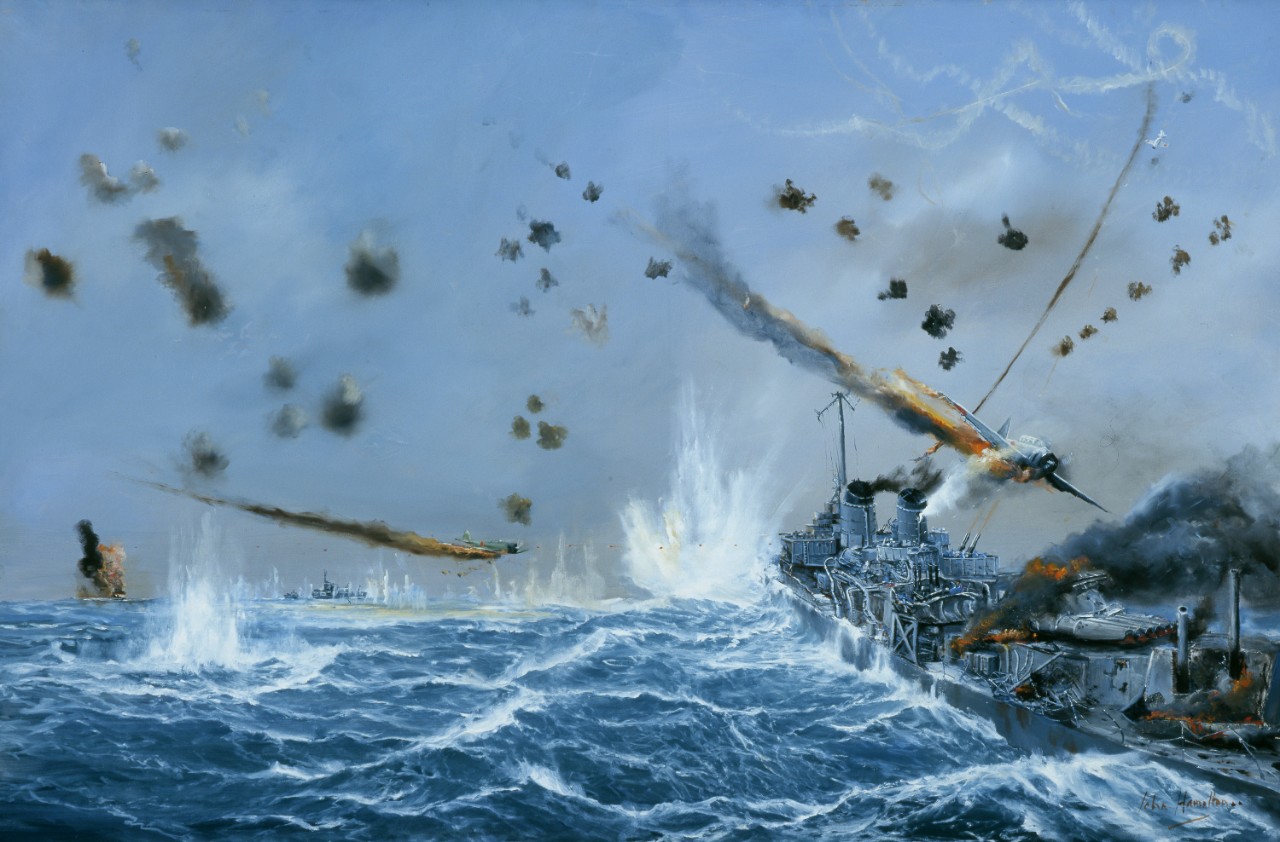
Kamikaze attack on USS Laffey. Painting, oil on wood, by John Hamilton.
![]() As seemingly commonplace as such incredible acts of perseverance and mental fortitude were during Okinawa, we must not overlook the severe physical and mental toll the campaign took on officers and enlisted alike. Even the famously unflappable Spruance was not immune. Admiral Chester Nimitz made the difficult decision to relieve Spruance and his staff before the campaign concluded because of combat fatigue. Having endured kamikaze strikes on two separate flagships, Spruance experienced firsthand the psychological toll and lethal consequences of such strikes. After his second flagship, New Mexico (BB-40) was hit, he wrote to his former chief of staff, Captain Carl Moore to explain the experience, emphasizing that, “The suicide plane is a very effective weapon, which we must not underestimate. I do not believe anyone who has not been around within its area of operations can realize its potentialities against ships.”[11] Mitscher also had to transfer his flag multiple time in the battle after kamikazes severely damaged two of his flagships. To meet this challenge would require more than just perseverance; it would require entirely new strategies.
As seemingly commonplace as such incredible acts of perseverance and mental fortitude were during Okinawa, we must not overlook the severe physical and mental toll the campaign took on officers and enlisted alike. Even the famously unflappable Spruance was not immune. Admiral Chester Nimitz made the difficult decision to relieve Spruance and his staff before the campaign concluded because of combat fatigue. Having endured kamikaze strikes on two separate flagships, Spruance experienced firsthand the psychological toll and lethal consequences of such strikes. After his second flagship, New Mexico (BB-40) was hit, he wrote to his former chief of staff, Captain Carl Moore to explain the experience, emphasizing that, “The suicide plane is a very effective weapon, which we must not underestimate. I do not believe anyone who has not been around within its area of operations can realize its potentialities against ships.”[11] Mitscher also had to transfer his flag multiple time in the battle after kamikazes severely damaged two of his flagships. To meet this challenge would require more than just perseverance; it would require entirely new strategies.
Learning in Real Time
Vice Admiral Marc Mitscher, commander, Task Force 58, is highlined from a destroyer to Randolph (CV-15) via boatswain's chair, 15 May 1945. This was the third time he had transferred his flag in four days, as his two previous flagships, Bunker Hill (CV-17) and Enterprise (CV-6) had both been badly damaged by kamikaze hits off Okinawa. Photographed by Ensign H.F. Barrett. Official U.S. Navy photograph now in the collections of the National Archives, 80-G-320987.
With the cost to men and materiel increasing daily, the Navy adapted its tactics to meet the growing kamikaze threat, perfecting radar pickets, adjusting combat air patrols, increasing attacks on land-based aircraft, and securing small islands for better fighter direction and early warning radar sites. In making these adjustments, the Navy not only learned how to counteract an unconventional threat, but also caught an early glimpse of a future in which bombs and torpedoes would give way to guided anti-ship missiles as a dominant instrument of naval warfare.
Radar pickets and combat air patrols served as the Navy’s primary weapons against the kamikaze threat. Both were well-worn by this point in the war, but the threat at Okinawa required adjustments to each. The smaller ships on radar picket duty served as the first alarm for the larger ships of the fleet. Because they were the first ships encountered by kamikaze pilots, they also became the first ships targeted. As attacks increased, the pickets were extended out from 40 miles to 60 to provide more lead-time for a counterattack. Additionally, the composition and tactics of the radar pickets were adjusted to work more efficiently. Each radar picket would ideally have had 4–6 DDs and 6 support craft with similar speed and maneuvering capabilities, but the large number of picket ships lost made this impossible. A mixture of ships ![]() with different capabilities meant each picket had to alter their group tactics when under attack.[12] Spruance also supported the radar pickets by ordering the seizure of small islands off the coast of Okinawa to establish extended fighter direction and early radar warning sites.[13] One flotilla commander declared after the battle, “Never in the annals of our glorious naval history have naval forces done so much with so little against such odds for so long a period."[14] Similar praise was commonplace with regard to the performance and perseverance of the picket ships.
with different capabilities meant each picket had to alter their group tactics when under attack.[12] Spruance also supported the radar pickets by ordering the seizure of small islands off the coast of Okinawa to establish extended fighter direction and early radar warning sites.[13] One flotilla commander declared after the battle, “Never in the annals of our glorious naval history have naval forces done so much with so little against such odds for so long a period."[14] Similar praise was commonplace with regard to the performance and perseverance of the picket ships.
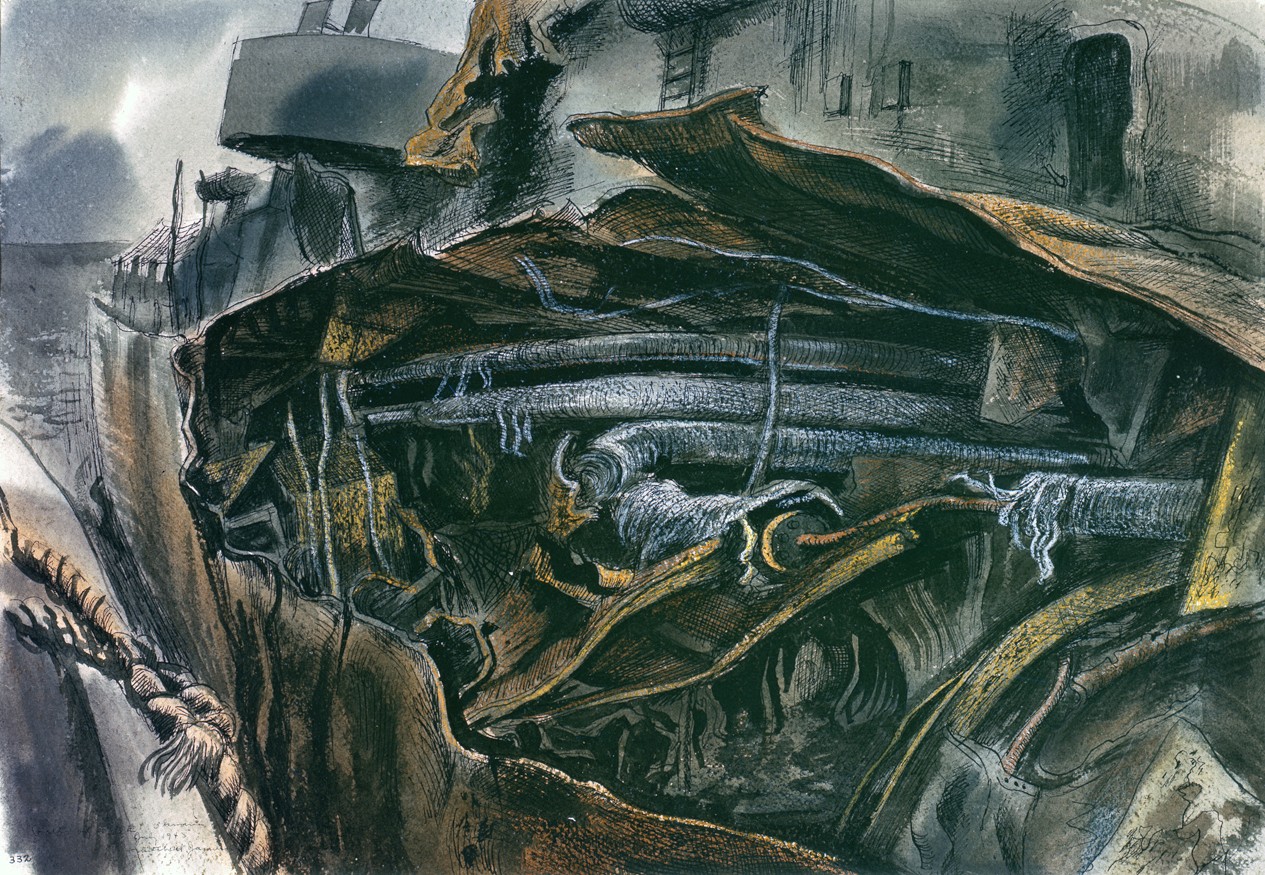
Guts of a Destroyer, Okinawa. Watercolor, crayon, by Mitchell Jamieson.
While the radar pickets acted as the fleet’s sacrificial lambs, the combat air patrols served as its primary defensive weapon against the attacks. Shooting down kamikazes before they could make attacks on ships, or Japanese bombers down before they could release Ohkas, was Fifth Fleet’s best weapon. Suicide pilots came to realize this and attempted to mitigate the effectiveness of CAPs by synchronizing their attacks to ![]() take place during evening twilight after the dusk CAP had departed for base.[15] As a result, the Navy made it a policy to double CAP during dawn and dusk and also supplement carrier-based CAP with U.S. Army Air Force assets based on Okinawa.
take place during evening twilight after the dusk CAP had departed for base.[15] As a result, the Navy made it a policy to double CAP during dawn and dusk and also supplement carrier-based CAP with U.S. Army Air Force assets based on Okinawa.
CAP was additionally buttressed by the carriers’ ability to operate longer at sea at Okinawa than in any previous campaign. The fast carriers were for the first time to be available at the target area for a prolonged period to furnish support and combat air patrols.[16] This flexibility came as a result of improved underway replenishments. In Mitscher’s TF 58 After Action Report, he reported they “operated at sea for 79 continuous days,” made possible by excellent replenishment services rendered by Task Group 50.8.[17] Okinawa proved that the fleet could keep close to hostile shores “for protracted periods at distances over 1,000 miles from our nearest base.[18] On the flip side, it also showed that such an “extended period at sea took its toll from both ships and men.” Machinery was not designed for such long continuous combat steaming. The need for major repairs mounted and personnel fatigue became a problem. Additionally, some 700 American aircraft were lost in operations at Okinawa. Underway replenishments did not deliver the much needed replacement parts for damaged aircraft and ships of the task force had to fulfill the needs of others from their own stock on the spot.[19]
Just as the U.S. Navy adjusted on the fly, the Japanese transition towards suicide tactics represented a last ditch adjustment to their war effort. Born just as much of desperation as they were cultural and ideological considerations, these tactics were not just limited to the air. Since 1944, the IJN had been developing and training crews to man explosive-laden suicide craft such as the Shinyo-class motorboats and Kaiten submarines. They even were in the process of training and developing platoons of frogmen armed with mines when the war ended. None of these proved nearly as effective as the aerial attacks (they only damaged a few ships at Okinawa), but they were a clear demonstration that the IJN was more than willing to sacrifice its sailors in the final stages of the war. This extended to its once-prized conventional surface force.
Although the IJN lost much of its surface fleet at Leyte Gulf (including battleship Musashi and most of its carriers), its leaders were not content to keep their remaining ships in port while the U.S. fleet drew ever closer to the mainland. Thus, they proposed one final sortie to Okinawa known as Operation Ten-Go, a kamikaze mission for all intents and purposes. Equipped with only sufficient fuel for a one-way trip, the goal of the Japanese fleet was to reach Okinawa, beach whatever ships remained, and fight to the death from the shore. At least some of the senior officers considered this plan ill-conceived, believing it to be far more effective to go out individually and attack the enemy supply lines until their luck ran out. However, they were overruled, leading RADM Keizo Komura (COMDESRON 2) to later lament, “Few people retained ![]() common sense in those days. A kamikaze spirit permeated the entire Navy."[20]
common sense in those days. A kamikaze spirit permeated the entire Navy."[20]
The force that sortied out of Tokuyama on 6 April 1945 was a pale shadow of the once mighty Combined Fleet, consisting of just battleship Yamato, light cruiser Yahagi, and eight destroyers. Lacking any sort of air cover, the task force would be woefully exposed to incoming air attacks from U.S. forces. Any hope of success relied on the element of surprise, but there was little chance of that. Indeed, that very night, two U.S. submarines had reported Yamato group’s movements. Further details emerged when a plane from Essex made contact at 0823 on 7 April. Wasting little time, Mitscher began launching his planes at 0915.
Contact was made with Yamato group at 1223. Despite the battleship’s considerable firepower, Yamato’s inexperience and ill-trained crew was little match for the veteran U.S. aviators. The gem of the Japanese fleet was pounded with five bombs and ten torpedoes before finally sinking to the bottom of the ocean at 1423. Most of the other ships fared similarly poorly, with only four destroyers surviving the onslaught. By the engagement’s end, an estimated 3,665 Japanese sailors had lost their lives (including roughly 2,500 on board Yamato) compared to only 12 U.S. aviators.[21] Clinging to debris from his ship, CAPT Tameichi Hara of Yahagi could only look on in envy as a Martin PBM Mariner swooped down to recover Lt. (j.g.) W.E. Delaney, while the Japanese sailors around him struggled to stay afloat.[22]
The Japanese willingness to essentially throw away its fleet in Ten-Go and its planes and pilots in kamikaze attacks was bred from desperation and military necessity. Having watched the ranks of experienced sailors and aviators gradually depleted over the course of the war, Japan’s military leadership knew full well they could not possibly hope to defend the mainland with inexperienced force that remained. Suicide tactics offered an alternative, allowing even the rawest of recruits (the average age of a kamikaze was 18 to 24) to make a meaningful contribution to the war effort. For many of the sailors and aviators, this was every bit as compelling of a reason to volunteer as social and cultural expectations (fear of shame, peer pressure, a specific interpretation of bushido). As one surviving kamikaze noted, “I do not believe the so-called suicide mentality is unique to the Japanese. The spirit of self-sacrifice exists in all countries among all people, particularly among the young, who are innocent and free of cynicism when they are in a wartime life-or-![]() death situation.[23]
death situation.[23]
The kamikaze attacks at Okinawa, as well as the fate of the Japanese fleet, should not be viewed as an historical aberration unique to the final stages of the war in the Pacific. It was, in fact, a preview of the future of naval warfare. Surface combat would no longer be characterized by ship-to-ship engagements, nor for that matter, even air-to-surface engagements like at Midway. While it is true that the main instrument of the kamikaze was the airplane, for all intents and purposes, these were human-guided missiles, easily shot down, but still capable of causing unacceptable losses. Navy leaders even began describing them as a primitive guided missile, with one noting, “[The] percentage of hits is higher because the missile [emphasis added] is aimable right up to the point of impact.”[24] Although it would be many years before self-guided anti-ship missiles became a reality, kamikaze attacks gave Navy planners a clear idea of just how severe a problem this technology (along with commensurate improvements to aircraft) would pose for any Navy fleet.[25] Countering such threats would not only require new tactics and greater adaptability, but also increased cooperation with Allies and other branches of the military.
Working as an Effective Team
Success at Okinawa would not have been possible without effective cooperation between the services and Allied partners. Such a task was easier said than done, as the operation required an elaborate command structure. Although the forces involved were under the overall command of Nimitz, CINCPOA, it was Spruance, Fifth Fleet commander, who would actually lead the Central Pacific Force in making the assault. Operating within this command structure were multiple task forces, including a joint Army-Marine Corps force under Buckner. To ensure the smooth functioning of this arrangement, clear delineations between Army and Navy commands needed to be established particularly since the campaign would eventually shift from an amphibious focus to the ground war. Spruance was given authority to establish when the point of transition took place but, even so, inter-service rivalries needed to be set aside to achieve victory. Despite the tensions that presented themselves at the command level, the Army-Navy-Marine team ultimately learned to work effectively.
Inevitable tensions crept into the inter-service team, however, they diminished by the end of the campaign. The pace of the Army’s advance south became the biggest point of contention for the Navy. Every day spent slowly advancing meant another day that U.S. Navy ships lay open to kamikaze attack. Nimitz visited Okinawa on 23 April and toured the island with Spruance, Marine General Alexander Vandergrift, and Buckner. Nimitz biographer E.B. Potter reported Bucker and Nimitz clashed during the visit. A comment from Nimitz to Bucker that the speed of ground operations needed to increase put the Army general on the defensive. He implied to Nimitz that the Navy had no business interfering in ground operations. Nimitz responded “Yes, but ground thought it may be, I’m losing a ship and a half a day. So if this line isn’t moving within five days we’ll get ![]() someone here to move it so we can all get out from under these stupid air attacks.”[26] Spruance expressed similar frustrations in a letter written to his former chief of staff the day after New Mexico was hit by a kamikaze. He indicated in the letter a wish that the Marines would have been the only ground force used. The “Army slow, methodical method of fighting” had led to an advance of only 4,000 yards in a month. The result was increased naval casualties. By this point in the campaign Spruance had come to determine that “I do not believe the Army is allergic to losses of naval ships and personnel.”[27]
someone here to move it so we can all get out from under these stupid air attacks.”[26] Spruance expressed similar frustrations in a letter written to his former chief of staff the day after New Mexico was hit by a kamikaze. He indicated in the letter a wish that the Marines would have been the only ground force used. The “Army slow, methodical method of fighting” had led to an advance of only 4,000 yards in a month. The result was increased naval casualties. By this point in the campaign Spruance had come to determine that “I do not believe the Army is allergic to losses of naval ships and personnel.”[27]
Spruance never expressed the above criticism of the Army publicly and regretted making it altogether after the war had ended and time allowed for a reassessment. The criticism was uncharacteristic of Spruance and more indicative of the strain put on him from the prolonged kamikaze exposure and loss of his Sailors.![]() [28] Nimitz also pulled back his criticisms of the Army realizing that they too were made out of frustration from mounting naval losses. When word publicly leaked during the campaign of inter-service quibbling, Nimitz immediately stepped in and put the matter to rest. In an unprecedented move, Nimitz convened a press conference at his Guam HQ to talk about the ongoing campaign. During the conference, he praised the Army’s tactics and “magnificent performance.”[29] Nimitz confessed in a private letter to his wife in the midst of the campaign that questions of the relationship between the Army and Navy were taking their toll on him. He worried that his letters were scrambled and apologized, “if my [word omitted by Nimitz] disconnected or incoherent remember that I am under great pressure these days-that does not originate with the Japanese.”[30]
[28] Nimitz also pulled back his criticisms of the Army realizing that they too were made out of frustration from mounting naval losses. When word publicly leaked during the campaign of inter-service quibbling, Nimitz immediately stepped in and put the matter to rest. In an unprecedented move, Nimitz convened a press conference at his Guam HQ to talk about the ongoing campaign. During the conference, he praised the Army’s tactics and “magnificent performance.”[29] Nimitz confessed in a private letter to his wife in the midst of the campaign that questions of the relationship between the Army and Navy were taking their toll on him. He worried that his letters were scrambled and apologized, “if my [word omitted by Nimitz] disconnected or incoherent remember that I am under great pressure these days-that does not originate with the Japanese.”[30]
The Navy additionally benefitted from the presence of TF 57, a British Carrier Force fully integrated into Fifth Fleet and almost entirely self-sufficient. Okinawa was the first time such an arrangement had been made and it worked nearly flawlessly. With 4 of Spruance’s 11 large carriers out of action within the first week of the Okinawa campaign, the Royal Navy carriers readily filled the void and covered the islands between Taiwan and Okinawa.[31] Although initially opposed to their inclusion, Spruance greatly appreciated their service by the end of the campaign and credited them with “greatly reducing the magnitude of enemy attacks upon U.S. forces and reducing our losses and damage and contributing materially to our success.[32] They also sustained their fair share of damage—all four of their fleet carriers were hit and damaged by kamikazes, but their steel decks fared better against the ensuing fires than the wooden ones of their American partners.
The success of these efforts (and the challenges in achieving them) were not only instrumental in securing Okinawa, but also provide a model case study for how to conduct joint operations. Although Okinawa was not the first major joint operation between the Army and Navy in the Pacific (the two had previously cooperated during campaigns in the Aleutians and the Philippines), the massive scale of these operations, the complicated command structure, and the strain placed on both services by the prolonged campaign and mounting casualties, demanded a considerably higher level of cooperation than had hitherto be demonstrated. The lessons learned during this operation would not be applied to an invasion of the Japanese mainland, but they would help shape strategies in conflicts to come.
—Richard Hulver, Ph.D. & Martin R. Waldman, Ph.D., historians, NHHC Histories and Archives Division
*****
[1] 5F Action Report, Ryukyus through 27 May 1945, 44. Available on Fold3.com.
[2] 5F Action Report, Ryukyus through 27 May 1945, 21 June 1945, 49. Available on Fold3.com.
[3] Samuel Eliot Morison, History of the United States Naval Operations in World War II. Vol. XIV(Boston: Little, Brown and Company, 1975), 281.
[4] Samuel Eliot Morison, History of the United States Naval Operations in World War II. Vol. XIV(Boston: Little, Brown and Company, 1975), 195.
[5] Vincent O’Hara, “Operation Iceberg’s Mixed Legacy,” Naval History, April 2020, 16.
[6] Commanding Officer, USS Natoma Bay (CVE 62), Amphibious Operations Capture of Okinawa 27 March to 21 June 1945 (Washington, DC: Office of Chief of Naval Operations, 1946), 7/70.
[7] COMPHIBPAC, “Suicide Plane Attacks,” 7 July 1945, 9. Copy in Admiral Turner Papers, NHHC Archives.
[8] Samuel Eliot Morison, History of the United States Naval Operations in World War II. Vol. XIV(Boston: Little, Brown and Company, 1975), 95.
[9] Jermiah Foster, “Franklin III (CV-13), 1944–1964,” Dictionary of American Naval Fighting Ships: https://www.history.navy.mil/research/histories/ship-histories/danfs/f/franklin-v.html.
[10] USS Laffey, “Report of operations in support of the invasion of the Okinawa Gunto, Ryukyu Islands, 3/25/45-4/22/45, including enemy bombing & suicide plane attack on 4/16/45 & AA actions,” 42A
[11] Spruance to Moore, 13 May 1945. Copy in Spruance Modern Officers Biography Files, NHHC.
[12] COMPHIBPAC, “Suicide Plane Attacks,” 7 July 1945, 6/7. Copy in Admiral Turner Papers, NHHC Archives.
[13] Joseph Alexander, “Hellish Prelude at Okinawa,” Naval History, April 2005, 5.
[14] Carroll Dyer, The Amphibians Came to Conquer: The Story of Admiral Richmond Kelly Turner, Vol. II (Washington, DC: Fleet Marine Force Reference Publication 12-109-II, 1991), 1084. Citing COMTASKFLOT Five, Okinawa Report, 20 Jul. 1945, p. 14.
[15] COMPHIBPAC, “Suicide Plane Attacks,” 7 July 1945, 4. Copy in Admiral Turner Papers, NHHC Archives.
[16] Roy Appleman, The War in the Pacific, Okinawa: The Last Battle (Washington, DC: U.S. Army Center of Military History, 1948, 2005), 31.
[17] Commander, Fast Carrier Task Force, Amphibious Operations Capture of Okinawa 27 March to 21 June 1945 (Washington, DC: Office of Chief of Naval Operations, 1946), 7/1 – 7/3.
[18] Commander, Fast Carrier Task Force, Amphibious Operations Capture of Okinawa 27 March to 21 June 1945 (Washington, DC: Office of Chief of Naval Operations, 1946), 7/1 – 7/3.
[19] Commander, Fast Carrier Task Force, Amphibious Operations Capture of Okinawa 27 March to 21 June 1945 (Washington, DC: Office of Chief of Naval Operations, 1946), 7/1 – 7/3.
[20] Tameichi Hara, Japanese Destroyer Captain (Annapolis, Md.: U.S. Naval Institute Press, 1961), 264.
[21] Samuel Eliot Morison, History of the United States Naval Operations in World War II. Vol. XIV(Boston: Little, Brown and Company, 1975), 202-209.
[22] Hara, 286.
[23] Hatsuho Naito, Thunder Gods: The Kamikaze Pilots Tell Their Story (New York: Kodansha International Ltd., 1989), 16.
[24] COMPHIBPAC, “Suicide Plane Attacks,” 7 July 1945, 1. Copy in Admiral Turner Papers, NHHC Archives.
[25] Albert Christman, The Grand Experiment at Inyokern: Narrative of the Naval Ordnance Test Station During the Second World War and the Immediate Postwar Years (Washington, DC: Naval History Division, 1978), 244.
[26] E.B. Potter, Nimitz (Annapolis, Md: Naval Institute Press, 1976), Nimitz, 374.
[27] Spruance to Moore, 13 May 1945. Copy in Spruance Modern Officers Biography Files, NHHC.
[28] Thomas B. Buell, The Quiet Warrior: A Biography of Admiral Raymond A. Spruance (Boston: Little, Brown and Company, 1974), 347. 358.
[29] E.B. Potter, Nimitz (Annapolis, Md: Naval Institute Press, 1976), 376.
[30] Nimitz to wife, 26 April 1945. Chester Nimitz Papers, NHHC Archives.
[31] Thomas B. Buell, The Quiet Warrior: A Biography of Admiral Raymond A. Spruance (Boston: Little, Brown and Company, 1974), 347. The carriers were Franklin, Enterprise, Wasp, and Randolph.
[32] 5F Action Report, Ryukyus through 27 May 1945, A-2. Available on Fold3.com.

